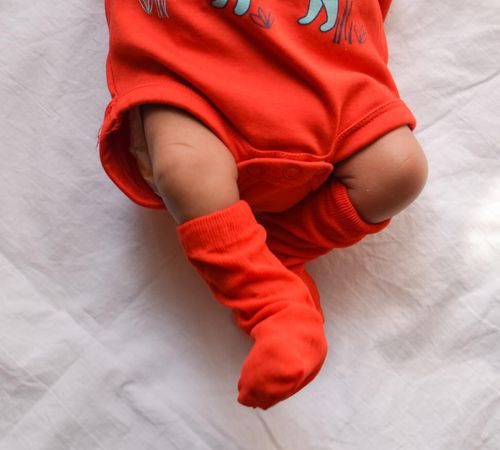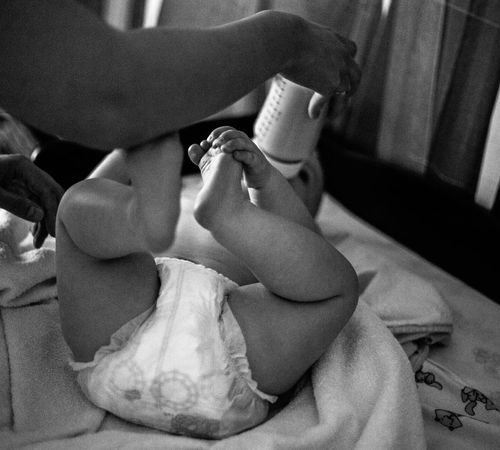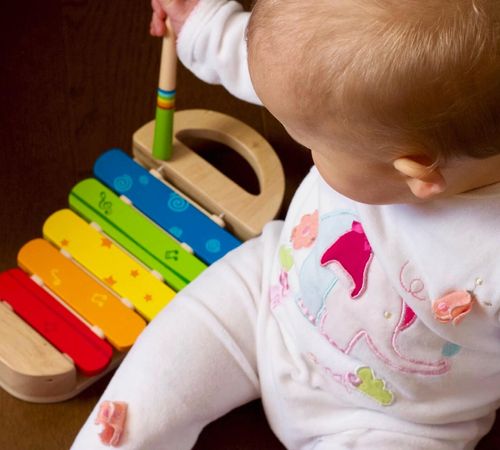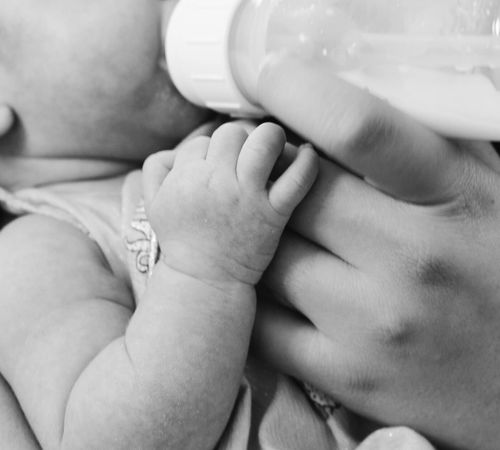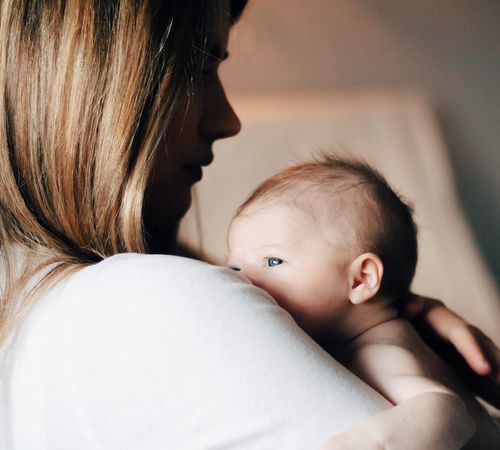The transition to one nap can be tricky for some babies. They seem to resist the nap, and yet you feel like they still need it to make it through the day. Learn when to drop to one nap and how to do it so your little one can easily handle the extra playtime.
I will be completely honest with you. Nap transitions can suck. Not only because it is time again to wave goodbye to another precious nap.
No, it's also because your baby is now in a phase I like to call "in between naps".
Your baby starts to resist the nap, and it takes much more effort to get them to sleep. So the nap gets delayed and delayed. Or now they don't want to sleep at home anymore, so you have to lure them out and get them to sleep in the car or stroller.
At the same time, they can now take really long naps and won't wake up if you don't wake, even though they resisted the nap in the beginning. Baby logic, right?
I love when my baby drops another nap...said no mom ever.
And if you skip the nap completely, they tear your home down because how dare you skip a nap they didn't want to take and fought so badly?
So clearly, your little one is on a mission to drive you koko with their sleep needs.
The thing is, the transition to one nap can be a really tricky one. But don't despair. You will find all the solutions to your nap transition struggles here, including when to drop to one nap and how to do it without your house burning down.
This article covers:
Signs Your Baby Is Ready To Drop A Nap
Sometimes parents are unsure if their baby is really ready to drop a nap or if they have hit a sleep regression or leap or teething or or or. :)
But if your little one shows some of these signs below for about 2 weeks or more, it can be an indicator that they are approaching their next nap transition.
These signs will especially be visible during the two-to-one nap transition:
Bedtime gets delayed
Whenever your baby is having two naps a day, their bedtime gets significantly delayed. By that, I mean for 45 minutes to 1.5 hours.
Before that, there are simply no tired signs from your baby.
Nap time gets delayed
Whether it is the morning nap or afternoon nap, one of them gets delayed.
In the morning, baby doesn't seem tired for their regular nap time. They might even fight naptime or start to protest. Getting them to sleep becomes a real challenge.
Nap time at home isn't working anymore
Your little one just doesn't want to sleep at home anymore. Every attempt ends in a fight or protest but never goes tearless.
This is really one thing that personally pushed my buttons. Just thinking about how to get my baby to sleep at home scared me. Because, honestly, I didn't always feel like going on a stroll.
To sum it up, your child only falls asleep peacefully in the stroller, car, or carrier. The main thing is that it happens on the go, and your child doesn't know you go out to get them to sleep.
Baby wakes more frequently at night or 45 minutes after bedtime
As your baby gets older, they need less sleep during the day. If they continue to nap even though they are basically ready to go without a nap, their nighttime sleep will automatically get less.
Your baby might suddenly start to wake more often at night. Or they wake 45 minutes after bedtime, and it's hard to get them back to sleep.
Worst case scenario: your little one wakes up in the middle of the night and stays awake for up to two hours playing and having fun. Yay!
What they practically do is compensate night sleep with day sleep. So in order to fix that, you new fewer naps during the day.
Early morning wakes
Early morning wakes are another indicator that your baby is getting too much daytime sleep.
They wake up early in the morning or earlier than usual because their sleep needs are simply met.
When Do Babies Drop To One Nap
Most babies drop to one nap between 13 and 18 months. 13 months can still be a tricky age to drop the nap. This will only work for low sleep needs babies.
Related Article: Low Sleep Needs Babies & Toddlers - How Much Sleep Your Child Really Needs
18 months is actually quite late to drop to one nap. But there are babies (dreamy babies, I would like to say) who still need two naps until this age.
The Benefits Of Dropping A Nap
Okay, I know that dropping a nap can somehow be terrifying. But there are also benefits that come along with fewer naps during the day. Yes, you read that right!
First off, you get an earlier bedtime. I love an early bedtime. For me, it marks the end of a successful day of surviving the and with the kids.
Secondly, if you have a baby that more frequently wakes at night, you might be better able to deal with this matter. Your baby will build more sleep pressure at night and might start to sleep better. And even if you decide to address the sleep situation at night, you might be more successful because the need for sleep will most likely be stronger.
There is also a good chance that bedtime battles will decrease. I know that everyone talks about bedtime battles and overtired babies. But at this age, bedtime battles develop mostly from undertiredness and attachment needs.
Which Nap To Drop
Most babies at this age will have a nap in the late morning (around 11 AM) and probably in the early afternoon (around 3 PM).
Some might have one short nap in the morning (around 9/10 AM) and then nap again at noon (around 1 PM).
In both cases, I recommend going for a nap schedule with one long daytime nap at around 12:00 PM. You don't want your baby to sleep too early in the morning because they will probably not have a long enough nap to make it until bedtime. Yet, you want the longest wake time between lunch nap and bedtime.
If your baby is usually having an early morning nap, you will change your sleep schedule like this: You will drop the morning nap and bring the second nap forward. The second nap should be at around 11/11:30 PM. Aim for a nap of about 1.5 hours. And then, as they grow, you can start to delay the lunch nap to 12/12:30.
If your baby has a late morning nap at 11 AM, you will drop the afternoon nap. Instead, you will now delay the morning nap to 11:30 AM/12 PM. Also, aim for a nap of around 1.5 hours. In this case, it may be harder for your baby to make it until bedtime because they are used to an afternoon nap. Therefore, you can push bedtime forward, and as your little one gets used to staying up for longer periods, you can delay bedtime again.
Methods To Make The Nap Transition Easy
Shorten the nap first
If you think your baby is not ready to drop the nap completely, start shortening it. I know waking a sleeping baby sounds scary, but this can help your baby get used to more awake time during the day.
Let them nap every other day
If you already have short naps, you can skip the nap every other day and see how your baby handles it. You don't necessarily have to go cold turkey. It's okay if, on some days, your little one still needs a power nap. It often depends on how their night was, when they got up in the morning, and your plans for the day.
Bring bedtime forward
Staying up until your regular bedtime will be a challenge for your baby in the beginning. So to prevent having an overtired baby, move bedtime slightly forward (30-60 minutes). Keep an earlier bedtime while your baby gets used to the longer awake window. You can gradually delay bedtime once your baby has completely dropped the nap.
Have low-key days
Children have sensory cups that need to be filled every day. Depending on how much their cup is filled, they will be more or less tired. If you are out all day long, your child will get more tired than if you integrate low-key afternoons at home. Until your little one gets used to longer wake windows, you can engage in more quiet play at home that doesn't cost them too much energy.
Have an afternoon snack
It is normal for children (and us) to have a dip in energy in the afternoon. You can start to offer a healthy afternoon snack for both of you to energize until dinner. For example, bananas, apple purree with oatmeal, or raspberries are good options.
Nap Transition FAQ
1. My child is having long naps. Doesn't that mean they still need two naps?
Not necessarily. If a 4-year-old would have a midday nap, they could probably sleep for 2 hours or more. Your baby is at an age where they show napping behavior we wish they had as a newborn. They can now easily sleep for a 2-hour stretch without making a move. But it doesn't mean they need it. This behavior just comes naturally as they grow in age
2. Because of the earlier bedtime, my child started to wake up early in the morning. What can I do?
Yes, this can happen as a not so pleasant side effect of an earlier bedtime. However, unless your baby is not waking before 6 AM, I am sorry to say that it is still considered a normal waking hour for babies and toddlers. Also, this will most likely pass since you are going through a temporary phase. You can slowly push back bedtime as your baby gets used to a longer wake window.
3. My child transitioned to one nap, but it's too short. How can I lengthen it?
Having only one short nap at noon can make it definately challenging to go through the rest of the day. But as mentioned before, cat napping usually ends by the age of 10/11 months. So if your baby is having a short midday nap, it is most probably a result of not being used to sleep at this time. Try to aim for a long nap of about 1.5 hours and try to resettle your little one if they wake earlier. It might not always work, but once your child adjusts to their new sleep pattern, the cat naps should disappear on their own.
4. Are 12 months too young to transition to one single nap?
While it depends on the baby, generally speaking, 12 months is early for most babies to drop to one nap. At this age, many babies hit the 12-month sleep regression, which leaves parents thinking that their baby doesn't need two naps. Baby either starts to have short naps or protests the nap. But most of the time, it's just an unfortunate effect of a sleep regression.
Final thoughts
I know that dropping naps can be tough. Sometimes you feel like you don't know what your baby needs, more or less sleep. But baby sleep is always changing. Try to show compassion that even dropping an extra 30 minutes of sleep can be a big deal for such little bodies. Try not to obsess about your baby's sleep and accept it as a gradual process. Because the next nap transition is already waiting for you. ;)



